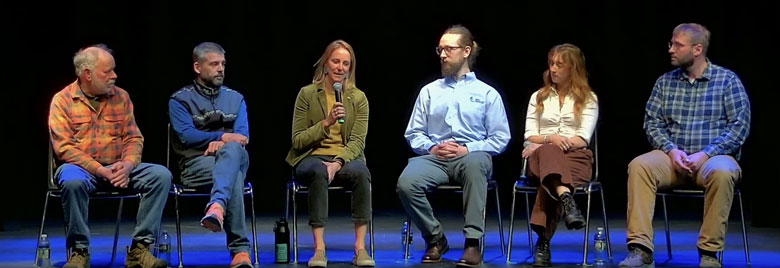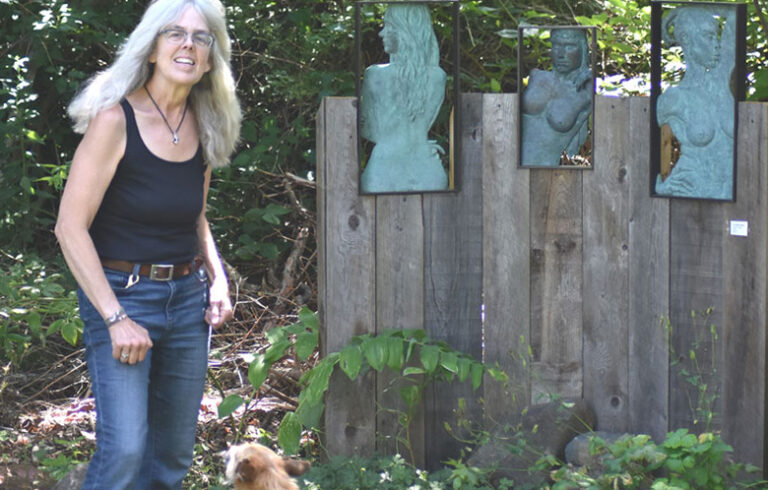Near the end of an April 24 panel discussion in Stonington, a speaker described what he hoped the harbor would look like 50 years from now. Today, early mornings see fishermen heading out in skiffs to their boats, off to haul traps in this top-landing lobster port. But in the future, those skiffs might be heading for a variety of ocean-based farms.
The scenario was described by Mike Thalhauser of Maine Center for Coastal Fisheries, a participant in the fourth and final “Talk of the Towns” panel discussion, this one on small-scale aquaculture.
“We want to keep our community on the water for generations to come,” moderator Linda Nelson said in introducing the discussion. Nelson serves as Stonington’s director economic and community development.
Brewer recounted traveling to Japan to learn about growing scallops on lines.
Key themes within the concept of aquaculture were the owner-operator nature of many of the businesses, the way growing seaweed and shellfish enhances water quality, and the opportunity for growth in this seafood sector.
Marsden Brewer, who now grows scallops on lantern nets in the water column, worked as a fisherman for many years. “I had every opportunity to fish,” he said, but his son would not have the same.
Brewer recounted traveling to Japan on a Maine Sea Grant-sponsored visit to learn about growing scallops, and he now has six years experience with the process.
“It’s a lot of learning,” he admitted, “but it’s working,” he said of his business, Pen Bay Farmed Scallops.
The scallops are suspended 10-15 fathoms (60-90 feet) deep linked to the surface by buoys.
Abby Barrows, who operates Deer Isle Oyster Company and also grows kelp, said her forays into aquaculture came with the future in mind.
“Growing up here, I recognized things were changing,” she said.
Her operation has the native Maine oysters in bags that hang from buoys. No feed is used.
“Tomorrow, we’re harvesting our kelp crop,” she said. The seaweed grows through the winter months.
Barrows said her lease site is for about 3 acres and 25 years in duration. A scientist who has focused on microplastics in the ocean, she said her goal is to build a plastic-free oyster farm.
To a question about how small operations might be expanded, Barrows said it’s a variable environment.
“It’s farming, and stuff happens out there,” she said. She hopes to secure a few more acres to be successful financially.
Brewer said his operation, which he runs with his son, is about 12 acres, but he hopes to expand it to 40 acres. He also grows kelp along with the scallops.
Christian Brayden of the Maine Aquaculture Association also was on the panel, and said a study showed that seaweed-growing operations of 8 acres or more prove to be profitable. Generally, aquaculture businesses typically take 6-7 years in operation before revenue begins to come in, he said.
Brayden described how he helps would-be entrepreneurs, meeting one-on-one with the “aqua-curious,” as he described them.
Brewer described the lease process—through which permits are granted from the state for use of portions of the sea—as “slow, burdensome,” but added that it’s effective.
The panel also included Kyle Pepperman of the Downeast Institute, a shellfish research center on Beals Island which operates a mussel hatchery that supplies seed to aquaculture farms, said the organization works to identify problems before they impact businesses.
Pepperman said lease applications, submitted to the Department of Marine Resources, are available for up to ten years for up to 100 acres. DMR hosts “scoping sessions” at which adjustments to location might be suggested. A formal hearing follows. Later in the discussion, former DMR Commissioner Robin Alden said from the audience that neighbors should engage in that scoping process.
“It’s important to attend the hearing if you have concerns,” she said, and added that the cumulative impact of operations in a small area can be considered by regulators.
Barrows urged those with concerns about a new farm to research the applicant’s track record, find out where they live, and learn what technologies they plan to use. A $5,000 bond must be filed with the host town to cover any repair costs to the operation.
Pepperman said asking about noise, and whether there would be lights on and boat traffic to the farm at night, also were advisable for land-side neighbors. Most applicants work to resolve concerns, he said, because “Angry neighbors are not good to have around.”
Jaclyn Robidoux, seaweed extension specialist with Maine Sea Grant, explained how some farmers use a checker-board arrangement with their kelp and mussel operations. She said in Maine, native kelp is used.
Asked about threats to these small-scale operations, Barrows pointed to land-side activities.
“I think there should be a lot more regulations on what we put on our lawns,” she said.





